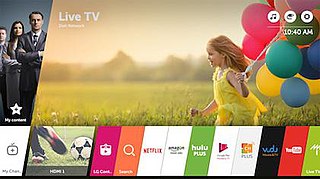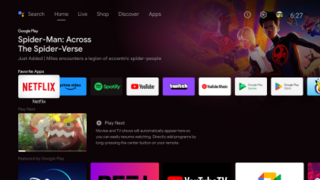
A home theater PC (HTPC) or media center computer is a convergent device that combines some or all the capabilities of a personal computer with a software application that focuses on video, photo, audio playback, and sometimes video recording functionality. Since the mid-2000s, other types of consumer electronics, including game consoles and dedicated media devices, have crossed over to manage video and music content. The term "media center" also refers to specialized application software designed to run on standard personal computers.

Roku, Inc. is a U.S. public company founded by Anthony Wood in 2002. It runs a streaming TV service through its branded streaming devices and smart TVs, supporting both advertising and subscription models on its platform. Roku leads U.S. streaming TV distribution, and reports over 80 million users globally as of 2023. Beyond the U.S., the company serves markets in Canada, Australia, the U.K., France, Germany, and several Latin American countries including Argentina, Brazil, Chile, Colombia, Mexico and Peru.
Now is a subscription over-the-top streaming television service operated by British satellite television provider Sky Group. Launched in the United Kingdom in 2012, the service is also available in Ireland, Italy, Germany, Austria, Switzerland and the United States.

ITVX is a British ad-supported video-on-demand streaming service operated by ITV. The service offers original content from the broadcaster, as well as some exclusive and licensed programming.

webOS, also known as LG webOS and previously known as Open webOS,HP webOS and Palm webOS, is a Linux kernel-based multitasking operating system for smart devices such as smart TVs that has also been used as a mobile operating system. Initially developed by Palm, Inc., HP made the platform open source, at which point it became Open webOS.

A smart TV, also known as a connected TV (CTV), is a traditional television set with integrated Internet and interactive Web 2.0 features that allow users to stream music and videos, browse the internet, and view photos. Smart TVs are a technological convergence of computers, televisions, and digital media players. Besides the traditional functions of television sets provided through traditional broadcasting media, these devices can provide access to over-the-top media services such as streaming television and internet radio, along with home networking access.

AirPlay is a proprietary wireless communication protocol stack/suite developed by Apple Inc. that allows streaming between devices of audio, video, device screens, and photos, together with related metadata. Originally implemented only in Apple's software and devices, it was called AirTunes and used for audio only. Apple has since licensed the AirPlay protocol stack as a third-party software component technology to manufacturers that build products compatible with Apple's devices.

Tizen is a Linux-based mobile operating system backed by the Linux Foundation, developed and used primarily by Samsung Electronics.
Miracast is a wireless communications standard created by the Wi-Fi Alliance which is designed to transmit video and sound directly from devices to display receivers. It can roughly be described as "HDMI over Wi-Fi", replacing cables in favor of wireless. The protocol is utilised in many devices and is used or branded under various names by different manufacturers, including Smart View and AllShare Cast, SmartShare, screen mirroring, Cast, wireless display and screen casting.

Chromecast is a line of digital media players developed by Google. The devices, designed as small dongles, can play Internet-streamed audio-visual content on a high-definition television or home audio system. The user can control playback with a mobile device or personal computer through mobile and web apps that can use the Google Cast protocol, or by issuing commands via Google Assistant; later models introduced an interactive user interface and remote control. Content can be mirrored to video models from the Google Chrome web browser on a personal computer or from the screen of some Android devices.

Roku is a brand of smart TV operating systems, smart TVs, streaming devices, and smart home and audio products designed and marketed by Roku, Inc., headquartered in San Jose, California, United States. Roku's smart TV products primarily offer access to streaming media content, including streaming television, from online services.

Amazon Fire TV is a line of digital media players and microconsoles developed by Amazon. The devices are small network appliances that deliver digital audio and video content streamed via the Internet to a connected high-definition television. They also allow users to access local content and to play video games with the included remote control or another game controller, or by using a mobile app remote control on another device.

Android TV is a smart TV operating system based on Android and developed by Google. It is available on television sets, soundbars, set-top boxes and digital media players. A successor to Google TV, it features a user interface designed around content discovery and voice search, content aggregation from various media apps and services, and integration with other recent Google technologies such as Assistant, Cast, and Knowledge Graph.
Google TV is a digital distribution service for movies and TV shows. It is operated by Google. Announced in September 2020, as a service it allows users to search and discover video titles available across multiple streaming services as well as to rent or to buy available titles from Google and add any selected title to a watchlist for watching or accessing such titles from eligible devices and platforms. The buy, rent or preorder options were also part of Google Play Movies & TV, another service by Google which later was moved to Google TV service.

Sling TV is an American streaming television service operated by Sling TV LLC, a wholly owned subsidiary of Dish Network. Unveiled on January 5, 2015, at the Consumer Electronics Show, the virtual multichannel video programming distributor aims to complement subscription video on demand services for cord cutters, offering a selection of major cable channels and OTT-originated services that can be streamed through smart TVs, digital media players and apps. The service is available in the United States and Puerto Rico as of 2015.

tvOS is an operating system developed by Apple Inc. for the Apple TV, a digital media player. In the first-generation Apple TV, Apple TV Software was based on Mac OS X. Starting with the second generation, the software is based on the iOS operating system and has many similar frameworks, technologies, and concepts.
The Apple TV app is a line of media player software programs developed by Apple Inc. for viewing television shows and films delivered by Apple to consumer electronic devices. It can stream content from the iTunes Store, the Apple TV Channels a la carte video on demand service, and the Apple TV+ original content subscription service. On iPhone, iPad, iPod Touch, Vision Pro, and Apple TV devices it can also index and access content from linked apps of other video on demand services.
HarmonyOS (HMOS) is a distributed operating system developed by Huawei for smartphones, tablets, smart TVs, smart watches, personal computers and other smart devices. It has a multikernel design with dual frameworks: the operating system selects suitable kernels from the abstraction layer in the case of devices that use diverse resources. The operating system was officially launched by Huawei in August 2019.
The version history of the HarmonyOS distributed operating system began with the public release of the HarmonyOS 1.0 for Honor Vision smart TVs on August 9, 2019. The first expanded commercial version of the Embedded, IoT AI, Edge computing based operating system, HarmonyOS 2.0, was released on June 2, 2021 for phones, tablets, smartwatches, smart speakers, routers, and internet of things. Beforehand, DevEco Studio, the HarmonyOS app development IDE, was released in September 2020 together with the HarmonyOS 2.0 Beta. HarmonyOS is developed by Huawei. New major releases are announced at the Huawei Developers Conference (HDC) in the fourth quarter of each year together with the first public beta version of the operating system's next major version. The next major stable version is then released in the third to fourth quarter of the following year.













